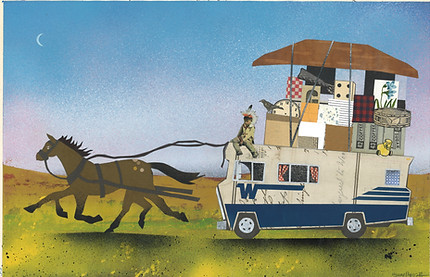Henry Payer
(Ho-Chunk)

Njjsoceja (Muddy Water) – Missouri River/Thurston County, 2022
Land collected from the Winnebago Indian Reservation on rawhide
12' x 16"
This work references an 1890 map of the Missouri River in Thurston County where the Winnebago Indian Reservation is located. I gathered land (dirt) from the reservation to act as the medium to map our territory before the Army Corps of Engineers rerouted the Missouri River in the 1960s, thus reducing the number of acres belonging to the Tribe. This work serves to place precedence on Land and our struggle to have access to different traditional cultural properties located throughout our history of removal and relocation.
Having access to our land allows us to be self-sustainable, to live grounded, and accommodate necessities from the land, including hunting for food, gathering medicine and room to practice ceremonies. The use of rawhide is one of these many natural resources, and acts as a connection to our ancestors of the Great Plains artistic aesthetic through a contemporary lens.

The Wandering Winnebago No 2, 2022
Collage and mixed media on ledger paper
15.25” x 10.5”
The Ho-Chunk people have a history of physical removal from our traditional homelands in Wisconsin. From 1832 to 1974, the Ho-Chunk were removed from Wisconsin to Iowa, to locations in northern and southern Minnesota, to central present-day South Dakota and to purchased land in Nebraska, establishing the Winnebago Indian Reservation before being allowed to take up homesteads throughout Wisconsin. All throughout this period of physical removals, the Ho-Chunk would venture back to their homelands in Wisconsin passing through these various states in the Midwest.
The Winnebago motorhome became an exonym, a name given by foreigners, for the Ho-Chunk people and it serves as a visual symbol for our plight and struggle to retain our identity.
The image of the boy depicted in this artwork, was taken from a Wisconsin Dells tourist booklet; the boy represents the youth, journeying along with the baggage of our Nation’s history in which each piece of baggage serves as a mnemonic device used to tell our story.

Henry Payer is a Ho Chunk artist who works primarily with collage and mixed media. Born in Sioux City, Iowa in 1986, Henry received a Bachelor of Fine Arts degree from the Institute of American Indian Arts in Santa Fe, New Mexico in 2008. He was invited to study at the University of Wisconsin-Madison and obtained an Master of Fine Arts degree in 2013. Henry has exhibited his work at locations such as the Great Plains Art Museum in Lincoln, Nebraska; All My Relations Gallery in Minneapolis, Minneapolis; Sherry Leedy Contemporary Art in Kansas City, Missouri; and Overture Galleries located in Madison, Wisconsin. His work has also been exhibited at the University of Venice Ca’ Voscari, Palazzo Cosulich in Venice, Italy. Henry has spent time as an instructor at the Oscar Howe Summer Art Institute located at the University of South Dakota in Vermillion. He currently lives in Sioux City, Iowa.
Henry’s narrative compositions are bold and contemporary. His works utilize Indigenous cartographic methods with traditional aspects of spatial representation and symbolism while appropriating European modernist models of cubism, spatial distortion and collage. Each work offers a visual narrative of symbols and appropriated voices from American consumer society that reconfigures history, references the altered landscape or the identity of a portrait. Henry questions our presumptions and challenges the dialogue of what is to be expected of Indigenous artists. He represents the work of artists seeking to expand the range and voice of their visual expression and cultural representation, while attending to concepts and forms of tradition.



